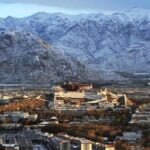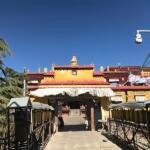The Lhalu Wetland (lha-klu-gsher-sa), located to the northwest of Lhasa city, is often referred to as “the heart of Lhasa.” In August 2005, it was designated as a “National Nature Reserve.” Established in 1995 and covering an area of 6.2 square kilometers, it stands at an average elevation of 3645 meters. Lhalu Wetland is recognized as the highest-altitude and largest natural urban wetland in the world and the only urban inland natural wetland in China. It consists predominantly of reed marshes and peat bogs.
The Lhalu Wetland, covering over 12 square kilometers, reveals its significance in the heart of Lhasa. This makes Lhalu Wetland a vast natural sanctuary amidst the urban landscape, offering a serene escape from the city’s hustle and bustle. A walk along the riverbanks, filled with the sounds of “ducks” splashing and calling, led to a beautiful but inaccessible bridge. Further exploration revealed a modest stone bridge leading to the wetland, invitingly open. This unexpected discovery felt like stumbling upon a hidden village of tranquility.

A Rich Biodiversity Haven
The wetland is home to predominantly reed communities and mesophytic Cyperaceae plants, along with 21 species of herbaceous plants. Experts estimate that Lhalu Wetland generates 53,700 tons of oxygen and absorbs 78,800 tons of carbon dioxide annually. This plays a crucial role in regulating the urban climate, enhancing air oxygen levels, maintaining groundwater levels, filtering sewage, maintaining ecological balance, and beautifying the urban environment.
Over 300 species of higher plants, 43 species of terrestrial wild animals, more than 30 species of aquatic wild animals, and 101 species of insects thrive here. It serves as an important habitat for state-protected species such as the Black-necked Crane and the Vulture, along with the Mallard, Common Pochard, Bar-headed Goose, Brown-headed Gull, Tibetan Sandgrouse, Skylark, and Lark among others for foraging.

The Return Journey: Reflections and Reminders
Sitting by the water’s edge, surrounded by the peaceful sounds of wildlife, offered a moment of reflection and appreciation for this natural haven. The return journey, prompted by park officials ensuring all visitors headed towards the exit before closing time, was a reminder of the vastness and untamed beauty of Lhalu Wetland.
Lhalu Wetland, a significant ecological and recreational asset in Lhasa, stands as a beacon of natural beauty and biodiversity, offering visitors a glimpse into the delicate balance between urban development and ecological preservation.

Visitor Tips:
- Access Restrictions: Currently, Lhalu Wetland is closed to the public, and unauthorized entry may result in fines. However, visitors can still enjoy bird watching from outside the fence, with the best season stretching from late autumn to the winter solstice.
- Getting There: Visitors can reach the wetland by walking, cycling, driving, or taking public transport from the city.
- Year-Round Beauty: Lhalu Wetland offers scenic beauty throughout the year, with June to October being the optimal months for visiting. The wetland becomes especially picturesque in autumn when the water and grass display a vibrant mix of reds and yellows, providing stunning vistas for photography enthusiasts.
Lhalu Wetland Nature Reserve stands as a testament to the rich biodiversity and natural beauty of Lhasa, offering a peaceful escape and a vital ecological function within the urban landscape.


















